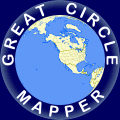Featured Map for 31 March 2011:
75th Anniversary of Hindenburg's First Trans-Atlantic Voyage
75 years ago, the Hindenburg (LZ-129) departed Friedrichshafen, Germany on its first crossing of the Atlantic Ocean, reaching Río de Janeiro after 100 hours and 40 minutes in the air. (The voyage actually terminated at Bartolomeu de Gusmão Airport in Santa Cruz, about 50 km southwest of Río de Janeiro, where a new airship hangar had been constructed.)
The French government failed to grant overflight rights, forcing the flight to take a circuitous routing via The Netherlands and the English Channel before proceeding along the Iberian Peninsula, then over the Canary Islands, Cape Verde Islands, Fernando de Noronha, and along the coast of Brazil. In addition, while over Pernambuco, Brazil, it was realized that Río de Janeiro could not be reached before dark. With new mooring gear and untrained crew, it was decided to defer landing until the next day, taking a leisurely path to show off the new airship.
Currently, TAM Linhas Aéreas flies Frankfurt to Río de Janeiro in an Airbus A330-200 seating up to 223 passengers with a 12:28 flying time. The Hindenburg's 100:40 flying time may seem glacial today, but in 1936 a Zeppelin was the fastest way to travel from Germany to South America. It was probably also the most luxurious option available to the 37 passengers aboard Deutsche Zeppelin-Reederei (DZR) flight 9, which carried a crew complement of 54.
Today's Featured Map illustrates the route of the Hindenburg's voyage 75 years ago along with the great circle routing from Frankfurt which approximates the route of a present-day airline flight. Many thinks to Daniel Grossman and his Airships web site for providing invaluable information for this map.
References and additional information:
- Airships: The Hindenburg and other Zeppelins
- Peck, Scott E., Lieutenant Commander, U.S. Navy. Report of observations while on duty in connection with German Rigid Airship HINDENBURG (LZ-129). 16 June 1936
- Dick, Harold G. and Douglas H. Robinson. The Golden Age of the Great Passenger Airships: Graf Zeppelin and Hindenburg. Smithsonian Institution Press: Washington, DC, 1985. ISBN 1-56098-219-5

- The Zeppelin – U.S. Centennial of Flight Commission
- The Zeppelin Museum
- D-LZ129 Hindenburg (detailed drawings)
- LZ 129 Hindenburg – Wikipedia
|
Information on this site may not be accurate or current and is not valid for flight planning or navigation. No warranty of fitness for any purpose is made or implied. Flight planning and navigation should only be done using official charts.
Copyright © 2010-2024
Karl L. Swartz.
All rights reserved.
|
